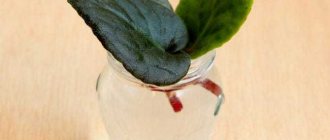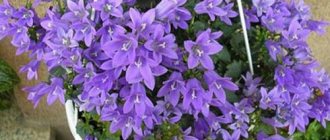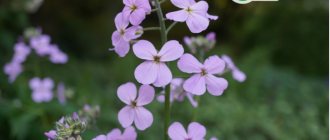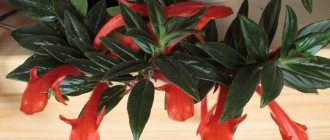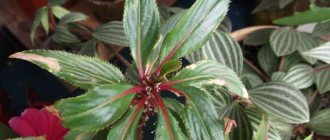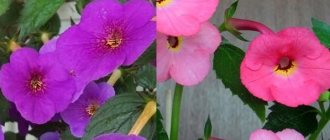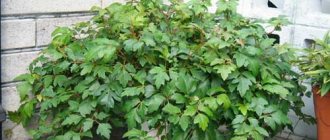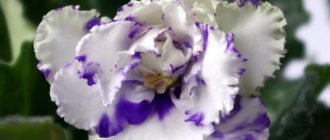Varieties of indoor plants: names, what they look like
On the European continent, cyclamen began to be cultivated as an ornamental plant in the 19th century, when the fashion for bright flowering varieties began. Currently, there are several of the most famous varieties of violets.
Persian cyclamen (Cyclamen persicum)
In this species, the roots have the shape of tubers - they can grow up to 15 cm in diameter, and small roots form from their lower part. The leaves are heart-shaped and can be 14 cm wide. The leaf blade is green below and has a silver pattern on top. Blooming flowers are pink, white or lavender in color, with darkish spots towards the base of the bud.
Cyclamen persicum
European cyclamen (Cyclamen purpurascens)
In Russia, this flower is known as grandma's cyclamen. It is an evergreen herbaceous plant with roots growing on all sides of the tuber, which is spherical in shape and grows up to 10 cm in diameter. The upper part of the dark green, heart-shaped leaves has a silver pattern. The bottom of the leaf is dark red. The soft pink flowers have a pleasant scent.
Cyclamen purpurascens
Additional Information! Unlike other varieties, the European one does not have a clearly defined dormant period.
Cyclamen Intarium (Cyclamen intaminatum)
The smallest representative of its family, originally from Turkey. On its shoots grow leaves of a round shape, dark green in color with silver splashes. Flowers may be white or pale pink without dark spots.
Cyclamen intaminatum
Cyclamen hederifolium
This species is characterized by pink flowers, which from August to November have violet-purple spots at the base of the bud. In this cyclamen, flowers appear earlier or simultaneously with leaves similar in shape to ivy leaves. That's why the plant got its name.
Lebanese cyclamen (Cyclamen libanoticum)
The flower is named after the Lebanese mountains, where it was first discovered in 1895. Between February and April it begins its flowering period and large pale buds bloom. They have small purple spots at their base. The leaves are quite wide, oval in shape. The surface of the leaf plates has a grayish-green tint and a marble pattern.
Cyclamen libanoticum
What does a Ness Crinkle Blue violet look like?
The variety is recognized as one of the best in the history of selection.
Plant characteristics
The Ness Crinkle Blue Violet is a semi-mini variety and has dark green, quilted and scalloped foliage. The ends of the sheets have pointed tips, and the leaf blade is velvety. The rosette is neat, with a diameter of 14 cm.
Violet Ness Crinkle Blue
Important! The main difference of the species is densely double flowers with a thin white border and dark blue stars
Briefly about the history of appearance
The variety was registered in 1995. Selection work was carried out by D. Ness. The name translates as “blue curls.”
Characteristics and features of Ness varieties
The varieties of the line are presented:
- Crinkle Blue or “blue fold” - has dark blue flowers with a thin white border.
- Orange Pekoe or “orange tea” - semi-double or double flowers of a coral shade; the features of the ness orange pekoe violet include the independent formation of a neat rosette, perfectly symmetrical.
- Satin Rose or “satin rose” - the double petals have a pink-silver-lilac hue, the tips are darker.
- Spring Blush or “spring blush” - refers to chimeras, has simple and semi-double flowers, multi-petaled, with an unusual shape; pink stripes with purple strokes are visible on the main white color.
- Blueberry Puff or “blueberry puff” - blue flowers with a slight haze and pink spots, creating the impression of sunbeams.
- Tiny Flame or “small flame” is a miniature species with terry, bright magenta buds.
- Pink Confetti or “pink confetti” is a semi-miniature type with simple or semi-double pink flowers and a thin border of the function color.
- Red Velvet or “red velvet” - simple bright red, large buds.
- Angel Face - light fuchsia bluebells with white tips, is a semi-miniature species.
- Antique Red - or "antique red" - is characterized by double dark red flowers.
- Fantasy Gold - interesting for its original color: rings of yellow, pink and fuchsia shades overlap each other; wavy black leaves are considered a special feature.
- Blueberry Kiss or “blueberry kiss” - has large, up to 6 cm in diameter, wavy blue flowers, with a large white eye.
Violet orange pekoe
Important! Ness orange pekoe violet is characterized by lush cap blooms, and Rob's Antique Rose (antique rose) has silver-pink petals with raspberry or cherry shades
Features of home care
The main conditions necessary for the normal growth and development of a plant are light, air, heat, water and nutrients in the soil. For Saintpaulia, especially important points are compliance with the technology and watering schedule, as well as choosing the optimal location for its placement.
The basic list of requirements and conditions for growing this plant includes several points.
Temperature The optimal temperature for growth is 20-23 degrees. They can tolerate a slight drop of 3-4 degrees. Lighting Lighting needs to be intense, daylight hours are long, but direct rays should be avoided. With a lack of light, Saintpaulia may not bloom, and the leaves may stretch upward. Watering Watering should be carried out in the pan, but the water should not stagnate in it. The difference between the temperature of water for irrigation and air by more than 5 degrees is unacceptable. Therefore, water for irrigation should only be used at room temperature. Spraying Saintpaulia leaves are not washed or sprayed.
Hairs on the surface of leaves have the ability to retain moisture - this leads to the development of rot. Humidity There are no special requirements for humidity, but it will be useful to place plants near vessels with water or trays with wet expanded clay. Soil For planting, use a ready-made soil mixture for Uzambara violets or mix 4 parts of deciduous soil and one part each of peat and sand yourself. Fertilizing It is recommended to apply complex mineral fertilizing at intervals of 12-15 days in the spring-summer period. It is permissible to apply cow manure diluted 1 to 10 with water, but care should be taken to avoid getting fertilizer on the leaves.
A tray with wet expanded clay increases humidity
Attention! For all Saintpaulias, the intensity of light and the length of daylight are very important. If there is a lack of natural light, additional artificial lighting should be installed
Reminder for a newbie!
Violet “bohemia”: description and cultivation features
Uzambara (Uzumbar) violet is a plant of the Gesneriaceae family, growing in the natural environment of tropical and subtropical regions of Asia, Africa, Eastern Australia, South America and the Indian Ocean islands.
Saintpaulia is a plant named after the Saint-Paul father and son, who brought a plant unknown to Europeans from the Uzambara district (modern Tanzania) in the 19th century, presented for the first time at the international flower exhibition in Ghent in 1893.
Indoor violet has been one of the most popular plants in indoor floriculture since 1927. By 1949, more than 100 varieties had been bred, and today their number exceeds several thousand.
Rooting
- possibly in water, in substrate, moss.
Priming
- purchased soil or a mixture of leaf, coniferous, turf and peat soil in a ratio of 3:1:2:1 with the addition of raising agents (perlite, vermiculite, river sand, crushed sphagnum moss.
Lighting - it is best to place flower pots on western or eastern windows. To ensure that the plant is evenly illuminated from all sides, the pots are periodically rotated. In winter, when daylight hours decrease, you can use artificial lighting - fluorescent lamps.
Caring is a real art and serious painstaking work at the same time, including watering, fertilizing, and creating a favorable humid climate. Water Saintpaulias as the soil dries. The soil must be moistened regularly, but excess moisture should not stagnate in the roots. When watering, you must ensure that water does not get on the leaves. You cannot water the Uzambara violet with cold water. Fertilizing is done with complex mineral fertilizer once every two weeks. Saintpaulia reacts negatively to a lack of nitrogen in the soil. Optimal air humidity is approximately 50%, temperature is 20-22 ° C, without sudden fluctuations and drafts. The leaves of the plant should not touch the window glass. Removal of faded flowers and damaged leaves is carried out regularly.
Reproduction - planting a leaf cutting, part of a leaf, or a daughter rosette. The most popular method is rooting leaf cuttings. The formation of roots and the development of children lasts 4-8 weeks.
Pests are one of the gardener's problems. There are many different types of pests and it is very difficult to classify them. Among Saintpaulia pests, several groups can be distinguished: mites (spider mites, flat mites, transparent mites, etc.), insects (aphids, thrips, springtails, poduras, scale insects, whiteflies, scale insects, etc.), worms (nematodes).
Diseases - distinguish between infectious (gray rot, powdery mildew) and non-infectious diseases (rotting of the stem and root, wilting of the lower leaves, yellowing, leaf spotting, incomplete opening and premature drying, falling of flowers) of plants. The causative agents of infectious diseases are bacteria, fungi, and viruses. To prevent infectious diseases, you should strictly observe the regimes of watering, temperature, humidity, and lighting. Non-communicable diseases usually arise due to poor agricultural practices. They may appear in one instance and not spread to others.
Watering
Violets need regular watering at the root. The soil in the pot should be moist, but not wet and stagnant. It is necessary to avoid getting water on the leaves to avoid their rotting and death of the entire plant. For this, the following watering methods are used:
- Immersing the pot in water.
- Watering from a tray.
- Wick moisturizing. This is when moisture enters a pot with a plant through a special device, the end of which is in a container of water, above which a flowerpot with a flower is located.
- Watering with a syringe.
To prevent the soil in the pot from becoming moldy, you can moisten the violet once or twice a month with water with the addition of phytosporin. For irrigation, use soft, lukewarm water, which must be left to stand for at least twelve hours. In winter, violets should be watered less often.
Care
This Saintpaulia, like the others, requires proper care. The main thing in this matter is the right location and optimal humidity.
Selecting a location
.Choosing a place for Humako Inches is not so easy, however, this factor is the key to regular flowering. The place should be lit, but without direct sunlight. Excessive light causes rotting of leaves and petals. In addition, drafts and too high temperatures should not be allowed.
There should be no more than one rosette in one pot, and the lateral shoots must be removed. The same applies to injured and dried areas, however, all this must be removed carefully, without touching healthy areas.
To ensure good flowering, diffused light is required for at least 12 hours a day. In order to make this period longer, in winter the plant must be moved to the south or west side, while providing artificial lighting. However, directly during flowering, the pot with the plant should not be rearranged under any circumstances.
Humidity and temperature
The optimal temperature for this Saintpaulia is considered to be +18–24 degrees Celsius. In winter, it should not be less than 10 degrees, as the plant will simply die. If the temperature, on the contrary, is too high, the violet will not bloom.
Humidity should be at 50%, this can be ensured by placing the pot on a tray with wet pebbles. In addition, spray bottles should be avoided.
Watering
As for watering, it must be regular and at the root level. The soil should be moist, but not very wet. In order to avoid rotting and the appearance of pests, all moisture that gets on the leaves should be wiped off immediately. The following methods can be used for irrigation:
- immersing the pot in water;
- watering from a tray;
- humidification with a wick;
- using a syringe.
To prevent mold from appearing on the soil, it is recommended to moisten the plant with phytosporin water at least once a month.
Top dressing
In summer and spring, Humako Inches need to be regularly fertilized with mineral supplements. They should be applied at least 2 times a week according to the following scheme: 2 grams per 1 liter of water.
Shortly before the budding begins, mineral complexes and fertilizers should be used in large quantities in order to increase the number of buds. To ensure the necessary flowering, fertilizers should be half as much.
Transfer
Another important detail for successful plant growth is replanting. It needs to be done about twice in one year, when the soil in the pot becomes depleted. The best time for this is spring.
The pot should be the same size as the old one, and the soil should be suitable for Saintpaulias. There must be drainage - it should occupy about half of the pot.
If the transplant is planned, then it must be carried out using the transshipment method. In case of unscheduled work (soil acidification or plant disease), complete or partial soil replacement is used
It is very important not to forget to check the condition of the roots and separate the daughter parts of the violet necessary for propagation
Reproduction
This violet is most commonly propagated by leaf cuttings. It is necessary to take a healthy and mature leaf from the very bottom of the plant, treating this area with charcoal after removal. Then a dark glass container with boiled water is prepared, and the cutting is placed there. Just a few weeks later, with the appearance of the first roots, the violet can be safely moved into a pot with soil.
There is also a method of propagation by seeds, but it is used much less frequently.
You will learn how to choose high-quality Humako Inches violets in the store and not make a mistake in the following video.
How to care for Saintpaulia
Caring for the Humako inches violet, according to reviews from flower growers, like most Saintpaulias, consists of choosing the right location, observing the temperature regime, optimal watering, fertilizing and maintaining the required level of air humidity.
- The violet should be placed in well-lit places, but should not be exposed to direct sunlight. The plant must be protected from drafts and ensure that its leaves do not touch the window glass.
- There should only be one rosette per pot. This rule applies to all types of violets, except for hanging ones. Appearing lateral processes must be removed.
- For successful flowering, you should also pick off wilted and damaged parts of the plant. This must be done very carefully so as not to injure neighboring leaves and peduncles.
For abundant flowering, which usually occurs from March to November, violet needs good lighting - bright diffused light for at least ten hours a day, and preferably 14-16 hours. To extend this period, pots with plants are placed in winter on southern and western windows and artificial lighting is used. During the flowering period, they cannot be moved to another place. The container only needs to be constantly rotated so that the lighting occurs evenly.
Diseases and pests
If the room where the violets are kept is too hot, they can be damaged by red spider mites. You can fight them by spraying the plant with systemic insecticides.
Violation of the temperature regime and waterlogging of the soil leads to the appearance of a disease such as black leg. The base of the stems turns black and thins, which entails weakening and death of the plant. In this case, it is necessary to completely replace the soil and disinfect it with Fundazol.
High soil and air humidity can lead to late blight affecting violets. The leaves become covered with brown spots, rot and fall off, as a result the plant may die. To prevent late blight, superphosphate should be added to the soil.
Thrips are dangerous pests of violets. They settle on the lower part of the leaves, and the larvae hatch in buds and flowers. Externally, this lesion looks as if the Humako inches violet is shedding pollen. To save the plant, all buds and flowers should be removed.
Root nematode is another dangerous enemy of violets. It attacks the roots of the plant. The disease can be recognized by the yellowing leaves of the plant. To save him, special potent drugs will be required. To avoid nematode infection, it is strictly forbidden to use ordinary soil on which cultivated plants grew to grow violets.
Despite the capricious nature and high requirements for living conditions, this variety of indoor flower is worth decorating your home with.
The violet will gratefully respond to the attention shown to it and will delight you with its abundant and lush flowering
Views: 19
Reviews
Humako Inches violet has won the hearts of some flower growers who are ready to share reviews about it based on their own experience.
Veronica Pavlovna. “At one of the exhibitions I immediately fell in love with this variety and decided to buy a baby. Violet turned out to be unpretentious. Even though, due to my constant busyness, I deprived her of attention, she pleased me with regular flowering. I didn’t find any flaws in it.”
Kristina Mikhailovna. “I grew Humako Inches from a leaf I cut from a friend. The flower developed surprisingly quickly and, in less than a year, pleased with its first flowering. The cap almost completely covered the rosette of leaves. I didn’t even expect such beauty from a young violet.”
Margarita Petrovna. “My daughter gave me Humako Inches for my birthday. In general, I liked Saintpaulia, but in summer the white color on the flowers is almost not noticeable; they all turn sky blue. I don’t have air conditioning, so I couldn’t provide the desired temperature in the room. I have to put up with this peculiarity of my new violet.”
Origin of violet
Violet, or Saintpaulia, got its name in honor of the German Baron Saint-Paul, military commandant of the German district in East Africa. It was he who discovered these modest blue-violet flowers while walking in the vicinity of his residence. From the seeds of this plant, his friend, a famous florist, grew a flower called Saintpaulia violet, which became the progenitor of all species now available.
By the middle of the last century, there were already more than a hundred varieties of this plant in the world. Currently, several thousand varieties of violets are already known, and the selection process does not end there.
Transplantation after purchase and during reproduction
One of the main conditions for the full growth of Saintpaulias and their annual flowering is proper planting. It implies the fulfillment of certain conditions:
- the drainage layer should occupy at least a quarter of the container;
- It is better to use ready-made soil for Saintpaulia, or mix garden soil, peat and sand yourself in a ratio of 2/1/1, respectively;
- After planting, the surface of the soil can be sprinkled with wood ash to disinfect and prevent rotting of the lower part of the leaves.
By following these simple rules, you can fully count on the rapid rooting of the flower and its active growth in the future.
The main thing is to follow all transplant rules
Violet, description and photo Humako Inches (Humako)
Saintpaulia varieties of foreign breeders “H” (Humako).
Humako Inches (Humako).
. (Inch).
White flower with a wide blue center.
Light green, smooth, rounded foliage. The leaf blades are very large. Standard. The socket is smooth and quite neat. The rosette is quite large, but can be grown compact if it is not allowed to grow long petioles.
A very spectacular variety with huge flowers. Large flowers 6-8 cm in size. All flowers are almost the same size. In hot weather, the flower appears blue.
From the first flowering it blooms immediately with a cap. Flowers completely cover the rosette. Flowers last a very long time, even in hot weather. Flowering is long-lasting, flower stalks constantly appear, replacing those that have already faded.
Propagates easily, grows quickly, blooms after 8 months.
There are two “variants” circulating among collectors, or rather two different plants with the same name. Real Humako Inches - with a smooth edge of the petals. The second variety was a test variety, no name, similar to Humako Inches, but the flowers are smaller and the petals have a wavy edge. It was not put into production (as it does not tolerate transport on an industrial scale), but spread among collectors. They suggest calling it Humako Inches 2, Humako Inches No name, Saintpaulia (Humako).
Do you know that…?
Many varieties fade in summer and there is less white if this color is present in the flower. Some are darkened, while others lose part of the color scheme. Darkening of color in summer is a fairly common occurrence in the violet world. At low temperatures, violets lighten. The same variety can bloom differently on your windowsill and on your shelf, in summer and winter. The same applies to green ruffles. The law of low temperatures works here - the lower the temperature, the more expressive and wider the green ruffle.
Before you buy the violets listed below, carefully read the forums about their behavior on the windowsill. Many of them are very beautiful flowers. However, these can be large rosettes with large and fragile leaves, with leaves rising up or hugging the pot, forming many stepsons that interfere with the formation of a neat rosette, pulling the stem up and growing into a Christmas tree, bending the trunk, rare flowering with long breaks, fallen flowers or they last little and quickly wither, very long and recumbent peduncles, the color of the flower fades quickly, they do not like bright lighting on the windowsill, they are afraid of the slightest drying out or waterlogging, a large percentage of them go into sports or darken the flower.
Are they suitable for your window sill and the conditions that you can create for them? You will look at the flowers for several months, and the rosette will always be in front of your eyes. There are many beautiful flowers, there are much fewer beautiful and neat rosettes, look first at the rosette! Search and you may find a dozen violets with the same flower color if you are not interested in the smallest details as a collector.
• — Happy Returns (Volkmann); • — Harbor Blue (Weber); • — Harmony's Frilly Dealy (Harmony's Greenhouse). • — Hood Wink (Dates). • — Hot Summer Day (Stork); • — Huron (Eyerdom);
Violet Humako Monique
Description of the variety
Varietal violet is a chimeric variety of the standard format. She voluntarily and relatively densely arranges all the newly emerging leaf blades into neatly decorated “floors,” which helps, as a result of maturation, to present the bush with a neat configuration.
The medium-sized leaves of the variety have an elongated rounded shape with a slight taper, a surface with a quilted-shimmering texture, almost smooth, serrated contours and rare graphics of enlarged venation.
The color of the rosette visually repeats the semi-dark shades of summer foliage; Sometimes a certain number of old plates in a bush may have brownish shading in their central part.
The corollas are simply filled with “pansies” petals with a clear chimeric color: basically white, sometimes with cream tints, the color of each petal in the very middle of it runs from the center to the tip, a wide, contrasting ribbon that distinguishes the varieties of chimeras, bright, bluish- lilac shades.
The corolla of a violet can look a little like a daisy with white and blue petals. The structure of the petals is light, luminous, with absolutely even contours.
Sports
Saintpaulia can occasionally sport the formation of almost white flowers with bluish highlights and chimeric leaves, decorated in the center with a stripe of a darker green tone.
Features of development and care
The violet has a relatively calm and easy character; it is unpretentious in care and independent in terms of the design of an almost exhibition leaf bush. Flowers on strong, stable peduncles appear at the usual time, flowering is luxuriant and in elegant caps.
The variety is very hardworking, almost a “workaholic”, since it blooms most of the year, leaving very short periods of time to replenish its strength.
ADVICE! Due to the possibility of periodic appearance of sports specimens, it is better to bring all the children to the first budding, which will allow you not to miss varietal plants.
Of the unpleasant nuances, one can only note the violet’s poor disposition to reproduce.
Reproduction
Saintpaulia is most often propagated by leaf cuttings. You can also use dividing the bush into rosettes and growing from seeds. It is worth noting that propagation by seeds is the most difficult, since it is a rather long and painstaking process.
Saintpaulias can be propagated by dividing rosettes
Important! You can get Saintpaulia seeds at home only through artificial pollination.
Vegetative propagation
Obtaining a new specimen of Humaco violet by rooting leaf cuttings is quite simple. The whole process consists of several stages:
- From an adult plant, several well-developed, not very young leaves are cut off with a sharp knife or blade, leaving petioles 3-4 cm long.
- Settled water is poured into a glass container and the stalk is fixed in it so that only the lower part of the petiole is in the water and the leaf is above the container.
- After 2-3 weeks, roots will begin to appear.
- When they reach 2-3 cm, the leaves are transplanted into a container filled with a mixture of peat and sand in a ratio of 2/1, deepening the cuttings into the ground no more than 2 cm. Next, a shelter is placed.
- The container is placed in a well-lit place, shading the seedlings from direct sunlight, maintaining constant soil moisture and a temperature of 21-24 degrees.
- When young leaves appear and reach a length of 2-3 cm, the seedlings are removed from the ground and planted in separate pots.
Propagation of Saintpaulias by leaf cuttings is the most optimal way. The survival rate of young plants is very high and after 8-10 months you can expect flowering.
Leaf cuttings quickly form roots
Transfer
For violets to develop successfully, they require regular replanting. The planned procedure is carried out once every two years, when the soil in the pot is depleted. This is done in the spring. The new pot should not be much larger than the old one. For replanting, you can buy a special soil mixture for Saintpaulias or prepare it yourself, taking three parts of leaf soil, five parts of peat and one part of river sand. Drainage should take up almost half of the pot. Planned transplantation is usually carried out using the transshipment method, that is, with the ground.
An unscheduled procedure is carried out as needed when the soil in the pot becomes sour, due to a plant disease, etc. It is usually carried out with a complete or partial replacement of the soil. During each transplant, be sure to check the condition of the root system and separate the daughter rosettes, which can be used for vegetative propagation.
Description and characteristics of Vat varieties
Tatyana Valkova became famous for her violets not only in her native country, but also in Russia and in many other countries. She regularly participates in exhibitions. The varieties she developed are in incredible demand.
Africa
Violet WaT Africa is distinguished by dark, rich purple petals, heavily corrugated along the edges. The inflorescences are located on a compact rosette of variegated leaves. It is often called African violet.
Mystic
The leaves are collected in a small neat green rosette. The flowers are large, with a large number of petals of original color. The main color of the petals is white, with patterns of pink and blue flowers randomly arranged on it, reminiscent of frosty ones.
Pulsar
The leaf rosette is small, almost invisible under the lush inflorescence. The flowers in it are large white with crimson inserts and patterns of various shapes.
Sun in the palm of your hand
The flowers are double, fluffy, white. Along the edges of the petals there is a greenish fringed edge, which turns pink towards the center of the flower. They are reminiscent of sunny, summer days, when the process takes place from the birth of the sun among lush green foliage to its rosy sunset. The leaves are deep green with white edges.
Poodle
The flowers are large, up to 7 cm in diameter, double, fluffy purple-pink in color with a blue fantasy pattern. The edge of the petals is corrugated.
Peony
Fialka vat Pion resembles a miniature copy of a lush, bright peony. Terry large flowers of raspberry color have a thin wavy white border along the edge. The basal rosette is lush, green leaves elegantly complement the bright inflorescences.
Aelita
Fialka Aelita has large, double flowers of soft pink color. Along the edges of the petals there is a wavy crimson border. The rosette is bright, variegated.
Carmelita
The flowers are large stars of violet color, close to plum. There is a wavy white border along the edges. The leaves are medium-sized, dark green.
Maleficent
An incredibly beautiful and unusual variety. The flowers are densely double, ball-shaped, dark purple in color. Ideally combined with white-green lush leaves.
Several varieties of VaT violets in one pot
White violets
One of the most popular white violets is White Pearl. The plant has semi-double or double flowers of dazzling white color with a yellow core. The volume of flowering is added by wavy petals, which are placed in several tiers. The rosette of the plant usually reaches 6-8 centimeters in diameter.
Saintpaulia Vologda lace also has unusual flowering. Smooth snow-white petals and a creamy center of the flower are most reminiscent of delicate lace on a bride’s dress; the comb type of flowering adds charm.
Another unusual specimen of the violet family is the Aristokratka variety. Voluminous white blooms with a soft pink tint give the Uzambara violet lightness and airiness, and the wavy terry petals make it even more refined.
ATTENTION! This variety of violets is best propagated by leaves so that the flower does not lose its varietal characteristics.
The white semi-double Saintpaulia Oscar, thanks to the comb type of flowering, as well as the green veins along the petals, resembles a lemon-colored butterfly.
The white and pink fan-shaped flower of the Scheherazade variety will add oriental charm to any floral collection.
With a purple center
In addition to the classic varieties from the white Saintpaulia palette, violet growers are also attracted by various variations of the combination of white with bright contrasting splashes.
Such varieties, in particular, include:
- Humako Inches;
- Shiawasee Trail;
- AB-Kilimanjaro;
- AB-Lace Lilac;
- AV-Romeo, as well as some others.
Humako Inches
Humako Inches (Humako) are a light, smooth flower with a purple-blue center. The inflorescences are shaped like large stars. Abundant flowering is produced by a small rosette of large, medium-green, openwork leaves.
Shiawasee Trail
The Shiawasee Trail variety blooms with small stars and has a mixed, so-called variable blue and white color. In combination of colors, this color resembles a light purple tint.
IMPORTANT! This variety is a sport, so it is recommended to propagate and replant it exclusively with leaves. This is necessary so that this variety does not lose its varietal characteristics.
AV-Kilimanjaro
Saintpaulia AB-Kilimanjaro are large double flowers consisting of wavy petals. When combined, they form a fan-shaped inflorescence, decorated with a small, medium-green rosette consisting of jagged, quilted leaves.
AB-Lace lilac
Lacy lilac is a large white with purple splashes and a light green edge of wavy rose petals, in the design of a rosette of jagged quilted leaves.
AB-Romeo
Unlike the Juliet variety, the inflorescences of the Romeo violet are snow-white, double, with a soft blue edging along the edges of the petals. The inflorescences have the shape of large roses. The rosette is neat, light green. The leaves are slightly wavy.
With blue border
Below you can see photos of white violets with a blue border, which are considered the most popular:
- Russian girl;
- Pat tracy;
- Iceberg;
- Arctic Frost;
- Mas Arctic Sky (O. Robinson).
Russian girl
Rossianochka is a varietal violet. Large semi-double stars of the inflorescences adequately complement the blue edges of the petals, corrugated with mother-of-pearl iridescence. The rosette is loose, long-petioled, with a bright green shagreen color.
Pat tracy
Another very spectacular variety from the white Saintpaulia palette. Large double stars with a neat blue border along the edge of the petals. A rosette of smooth green leaves completes the image of the plant.
Iceberg
The Iceberg variety can be represented by large snow-white semi-double or double stars with a corrugated blue border along the edge of the petals. The leaves are smooth, light green, wavy.
Arctic Frost
Varietal violet from the collection of breeder S.Sorano. Inflorescences are in the shape of large snow-white semi-double stars with a pearlescent tint. The leaves of the rosette are medium green. The socket is straight.
Mas Arctic Sky
Snow-white semi-double Pansy with a soft blue ruffled edge, decorated with variegated, white-green, quilted foliage.
Possible problems in growing
There are several contraindications that relate to cultivation. The flower, by its appearance, will give clues regarding further actions. Sometimes there are problems with leaves, diseases and insects. But these are rare and isolated cases.
Features of cultivation
What do problems with leaves mean?
The appearance of a leaf can indicate many things:
- yellowing - excess moisture;
- drying of the tips - insufficient irrigation;
- folding - the need to fertilize the soil.
Important! Other signals from the leaves may be associated with an incorrectly selected planting site
Diseases
The common violet often succumbs to diseases associated with rotting of the root system. In addition, it can be affected by powdery mildew and gray rot. Tricolor is more resistant to any type of disease.
Pests
Bushes are rarely attacked by pests. Sometimes ants can live between the roots. The spider can spin a web between specimens - a common phenomenon for outdoor flowers.
Plant resistance to diseases and pests
Other problems
With the indoor version of the flower, problems may arise in terms of cultivation, breeding and care. Diseases often appear. Outdoor specimens are more resistant to weather conditions, harsh climates and external factors.
Triflower herb is considered medicinal and is often used in many areas of cosmetology. Previously, the plant was very popular among healers and physicians. Now many hybrids have been bred that are only superficially similar to the wild “ancestors”. Such specimens are resistant to weather conditions, diseases and pests. The aesthetic appearance captivates flower growers. The three-color color scheme is especially attractive.
Features of caring for Humaco inches violet
The culture is not demanding in terms of care. There are some content rules that need to be followed.
Selecting a location
In the wild, the flower grows in rock crevices, at the bottom of gorges, near waterfalls, that is, in shaded and damp areas. In a home greenhouse, choose a bright place, but without direct sunlight. Ultraviolet radiation destroys the rosette, leaves and flowers, which rot. At midday the pot is shaded.
Important! One rosette is kept in the container, the side shoots are removed. The rule does not apply to hanging species
Trim dried elements and injured leaves
Do this with caution so as not to touch the peduncles
Violet requires 12 hours of diffused light. When daylight hours are short, artificial lighting is provided with fluorescent lamps.
Air temperature and humidity
The flower grows well and blooms for a long time at a temperature of 20-24 °C. In winter the temperature should be 10 °C. At lower thermometer readings, the flower dies. If the temperature is too high, it will not bloom.
The culture does not tolerate through winds. When it gets too cold, the roots rot.
Air humidity should be 50%. If it is lower, place the container on a tray with wet expanded clay and spray the air around it.
Watering and spraying
Water at the root. The soil in the dishes is kept wet, but not with stagnant moisture.
In summer the flowers become whiter
Watering methods:
- immerse the container in water;
- water through a tray;
- using a wick. It is placed in a bowl of water, and above it is a flower pot;
- moisturize through a syringe.
To prevent mold from appearing in the flowerpot, it is spilled with phytosporin once a month. In winter, watering is reduced.
Important! Water for irrigation is left to settle for 12 hours. The leaves are not sprayed.
Priming
Soil requirements:
- breathability. To do this, baking powder is added;
- moisture capacity;
- acidity pH 5.5-6.5.
The soil must contain phosphorus and potassium. Potting mixes at flower shops may have an overabundance of them. They also contain parasites. Therefore, mixtures are prepared independently from peat, moss, perlite, and charcoal.
Before use, disinfect by baking in the oven.
Note! After disinfection, the soil is spilled with a solution of trichodermin, phytolavin-300. They populate the soil with beneficial microflora that will fight pathogenic organisms
Feeding
The flowering of Humako inches pink violet depends on feeding:
- complex mineral fertilizers. They are sold in liquid form in agricultural stores with the inscription: “For Saintpaulias”, “For violets”. Dilute according to instructions, water at the root;
- banana peel. Make an infusion from one peel, filled with 1 liter of water. After several days in a warm place, water, after moistening the soil;
- sweet water. Sugar (1 teaspoon) is stirred in 1 liter of water. Water once a month.
When the crop blooms, fertilize it 2 times a month. In winter, fertilizing is reduced.
Possible problems in growing
When growing Saintpaulias at home, many problems can arise. Most of them are the result of violation of care conditions: increased humidity levels, poor lighting, drafts, improper watering.
Important! A violet planted in a container that is too wide will not bloom until it fills the entire surface of the earth.
Problems with leaves
Among the difficulties that you may encounter are disorders associated with the leaves of the plant:
- yellowing;
- appearance of spots.
In the first case, the plant may require rejuvenation or relocation to a less lit place. You should also reduce the dosage of applied phosphorus fertilizers. Spots appear when various pests appear.
Pests
The violet is most often attacked by certain insects:
- different types of ticks;
- scale insects;
- nematodes.
If the degree of infection is weak, the damaged parts of the plant are destroyed, and the rest are treated with acaricides. In other cases, it is better to get rid of the flower.
Diseases
The delicate Humako violet often suffers from typical synpolia diseases:
- gray rot;
- powdery mildew;
- rust;
- late blight
In some cases, the plant can be saved by treating it with special means, but more often it is recommended to destroy it along with the pot.
Signs of improper care
Regular preventive inspection of indoor violets allows you to promptly identify the slightest deviations for the worse in the growth, development, and appearance of flowers.
Signs of poor care may include:
- crushing of flowers and dullness of their colors;
- stretching leaf petioles and lifting them up;
- curling the edges of the leaves inward;
- wilting and yellowing of leaf blades;
- blackening of the edges of the leaves;
- withering of flowers and unopened buds;
- lack of flowering.
By detecting one or more problems in the early stages, you can correct the situation faster with less damage to the flower.
Healthy Violet Humaco Inches
Growing violets in pots at home is not particularly difficult. It is enough to follow the simplest rules, paying a little attention to the flowers, and they will delight you with lush blooms throughout the year.
The hybrid variety Humako Inches is unpretentious, but loves attention and care like any other
https://youtube.com/watch?v=QGZTGDTG-IE
vote
Article Rating
Possible problems during cultivation
Macho violet: secrets of growing and propagating a prolific variety
As a rule, if you follow the rules for caring for Uzambara violets, there are no problems with their cultivation. Deterioration of leaves, general appearance, or lack of flowering may be caused by improper care. Sometimes problems arise as a result of pests and diseases.
Change in leaf condition
The most common problem with Saintpaulias is deterioration of the leaves. There may be several reasons for this:
- placement of pots too close (the leaves of neighboring flowers touch);
- excessive watering;
- incorrect landing;
- pest damage;
- root system disease;
- lack of light.
All these factors can cause the appearance of spots on the leaves or the development of rot in the cuttings.
Changing the condition of the leaves is a sign of disease
Important! Plants should be inspected regularly and appropriate measures should be taken at the first sign of deterioration.
Pests and diseases
All varieties of Saintpaulia, and especially varietals such as Humako inches, are susceptible to the following diseases: fusarium, late blight, powdery mildew, and various rots. The cause of the disease may be improper care or infection from another neighboring plant. Cyclamen mites and aphids are also dangerous.
At the first signs of the disease, measures should be taken and the necessary treatment should be carried out. It is also necessary to isolate the diseased flower from other plants until complete recovery. In especially severe cases, it is recommended to transplant into another pot and completely replace the soil.
Systemic insecticides are used against pests, which can easily be found in a flower shop.
Improper care
Growing Saintpaulias requires strict adherence to the rules for the care and maintenance of these flowers. They are very sensitive to temperature changes, drafts, and non-compliance with the watering schedule.
Any deviation from the flower care program will lead not only to a deterioration in its appearance and lack of flowering, but also to the death of the plant.
Saintpaulia, commonly known as violet, Humako inches is a wonderful representative of the Gesneriev family. This flower is quite unpretentious. By following simple care rules and providing optimal maintenance conditions, you can admire the flowering of this beautiful Saintpaulia for 8 months a year.
Description and features of Humako Inches violet
Origin
This plant is another variation of the sensational Saintpaulia, however, in common parlance it is usually called violet. The name of this Saintpaulia comes from Germany, more precisely, from the German Baron Saint-Paul. It was he who first found these amazing flowers in the area around his residence.
A famous breeder, a friend of Saint-Paul, grew the first Saintpaulia from the seeds of a found plant, which became the ancestor of the currently existing species. Literally half a century later, there were already about a hundred varieties of this flower all over the Earth. There are already about three thousand of them in the modern world, but breeders don’t stop there.
As for Humako Inches, when translated into Russian the name is translated as Humako Inches. The first word is the name of a popular Dutch company specializing in violet breeding. The second word speaks about the size of the flower.
Description
In the regions of East Africa you can find this evergreen herbaceous plant growing up to 30 centimeters in height. In room conditions, the sizes are, of course, smaller.
The variety itself belongs to the Gesneriaceae family, to the genus of hybrid Saintpaulias. The plant is truly beautiful and graceful, with quite large flowers. Light green, oval-shaped leaves are collected in a rosette. They also have small villi and the leaves are pointed at the top.
Violet flowers are white with a blue center. They are collected in one brush, about five or six pieces each. Flower petals can be double or semi-double. In the first case there are many additional petals.
The fruits look like small capsules containing seeds. The plant propagates very simply and quickly.
The flowering process lasts a long time (from March to November), while the flowers bloom and become lush, covering the entire rosette. Old peduncles are replaced with new ones.
It is worth noting that in the summer, with extreme heat, the white tint becomes slightly less, while the concentration of blue color increases. At low temperatures, on the contrary, there is more white color.
Also, experienced breeders tend to believe that Humako Inches have two variations. The real plant has petals with smooth edges, while the other is a test plant, but is much more common in stores. The flowers of these plants are slightly smaller and have wavy edges.
Violet Humako Candy
Description of characteristics
The violet is an unrealistically magical standard suitable for growing in the collections of all violet growers: its tiers are independently filled with a dense volume of leaves, the rosette represents a neat plant with perfect symmetry on all sides.
Round-heart-shaped, medium-sized leaf plates with a sharp end are characterized by a soft quilted surface, unusual uniformity of the venation pattern, smallish, evenly shaped serration of the edge edges and a rich color of green volume.
Varietal Saintpaulia forms a bouquet of large corollas of simple configuration, shaped like the “pansy” segment. The flower petals are framed by light, graceful edge curves, giving the violet a special charm.
The main tone of the petals consists of shades of a delicate pink palette with coral reflections. In the central part of the corolla there is a white spot with clear contours, which may spread slightly onto the edges of the petals.
Feature of development
Saintpaulia is characterized by a simple and uncapricious character, easy adaptation to the microclimate of indoor collections and has several plus distinctive touches:
- independence in the formation of a socket;
- ideal outlines and neatly compacted borders of the rosette;
- fast and trouble-free growth;
- the incomparable decorativeness of large corollas.
CAREFULLY! It is necessary to carefully monitor the temperature gradient at the moment of laying the buds and opening the corollas, since varietal violets tend to fade in color from the heat.
How and when does it bloom
Uzambara violet Humaco inches has a very long flowering period. As a rule, it begins in March and lasts until the end of November. In rare cases, you can see flowering specimens even in winter.
An interesting fact is that there are two types of this plant, new and old, which differ in the shape of the petals on the flowers. A true representative of the variety is considered to be Saintpaulia with large simple petals, and the presence of slight waviness along the edge is considered a sign of an experimental subspecies. Both varieties can be found not only in private collections of lovers of Uzambara violets, but also on public sale.
The peculiarity of the experimental variety is wavy petals
Features of care during flowering
The most anticipated moment when growing Saintpaulias is the flowering period. To prolong it and provide the flower with optimal conditions at this time, it is worth considering several important points:
- you cannot move the pot with the plant to another place;
- watering should be carried out especially carefully, avoiding moisture on the flowers;
- it is necessary to regularly apply mineral fertilizers at intervals of 10-14 days;
- wilted flowers must be carefully removed.
Another point concerns young plants. Typically, Uzambara violet blooms at the age of 8 months. If the buds began to form earlier, it is better to remove them. This will allow the young plant to fully increase the vegetative mass and develop the root system.
Features of flowering, growth and reproduction
The Humako Inches violet has certain characteristics not only in cultivation and care, but also in flowering, growth and methods of reproduction.
Development at home
Saintpaulia already blooms with a cap. The rosette is completely covered with inflorescences. New flower stalks are constantly being formed and replacing those that have already faded.
How long does it take to grow an adult plant?
A full-fledged plant grows in about 6-7 months . Flowering occurs within 8 months after planting the violet.
Varieties propagation methods
Saintpaulia Humako Inches primarily reproduces by leaflets . This method ensures good survival rate and transfer of varietal qualities.
Leaf propagation.
When sowing seeds, the growing process is lengthy and labor-intensive, and there is no guarantee that the resulting seedlings will have the declared varietal characteristics.
Features of flowering
In hot conditions, the Humako Inches violet almost completely stops flowering. Flowers may appear blue; the white color almost disappears. If the flower is grown in a cool room, the color is more saturated and many flower stalks are formed.
The flowers reach a diameter of 6-8 cm, their size is almost the same. Their color is white, the middle is wide, blue-blue.
With proper care and following the growing rules, the Humako Inches violet blooms immediately.
Humako inches is characterized by cap flowering.
The flowering period of this variety is long. New flower stalks constantly replace faded ones. The flowering time of one bud is about 1.5 months.
How to propagate violet Humaco Inches
There are two ways to propagate this variety of violet: by seeds and cuttings. Growing from seeds at home is extremely rare. Most likely, the florist will not even find them in regular flower shops. The plant requires increased care at different stages of cultivation, so it is easier to take a cutting from an adult healthy plant.
Gradually, new leaves will appear around the rooted cuttings.
Description of violet cuttings:
- A strong leaf is taken from the mother plant from the lower tier of the rosette.
- The leaf is cut at an angle, and the cut area on the flower is treated with activated carbon.
- The cut leaf is placed in a container (preferably made of dark glass) with water at room temperature.
- After 1.5-2 months, roots appear at the cut, and the leaf can be planted in the soil.
Experienced gardeners root violet leaves in moistened sphagnum moss or directly in the ground.
If you properly care for your indoor violet, it will decorate your home with its lush blooms for almost a whole year.
This plant is unpretentious, but loves regular attention and care.
https://youtube.com/watch?v=QGZTGDTG-IE
Propagation of violet Humaco inches
The plant is propagated by leaf cuttings. A healthy mature leaf plate is cut at an angle from the mother bush. Select the bottom sheets. The cut is disinfected with activated carbon and placed in boiled water. The dishes are chosen in a dark color. The water is changed periodically.
By the end of the second month, roots appear. The leaf is transferred to a shallow pot with drainage and nutritious soil.
You can root the leaf in damp sphagnum moss or directly in the ground.
Note! The seed method is ineffective and labor-intensive; only enthusiasts do it. Seeds are not sold in stores
The flower is also propagated by rosettes, which are separated from the mother bush during transplantation. Plant immediately in a separate container.
Names of similar plants with which violets are often confused
There are many similar plants. This most often happens with:
- primrose. Perennial plant with lilac, pink and blue flowers;
- petunia. Bush plant with flowers of different shades;
- deikun. Loves slightly shaded places, does not tolerate drafts, and the flowers are about 4 cm in size;
- Streptocarpus. Its flowers look like umbrellas, and the plant grows up to 30 cm in height;
- gloxinia. It has purple, white and red leaves that feel like velvet to the touch. Gloxinia leaves are very similar to violet.
- garden viola. Requires careful care. The plant does not tolerate the scorching sun, so it is planted in the shade. The bush has a height of no more than 30 cm.
Varietal features
Many violets tend to swim when the temperature rises. If there is white in their color, it becomes less in the heat. This happens quite often. At low temperatures, plants lighten. All this applies to the Humako inches violet, whose flowers become more blue in the heat.
Collectors recognize two different plants called Humako inches. The true Humako inches violet has petals with smooth edges. The second known variety is a test variety. It was not put into production due to the fact that it turned out to be impossible to transport plants on an industrial scale. But they have become quite popular among amateur gardeners. Their flowers are not so large, but have wavy edges. This species is called Humako inches-2, or Humako inches No name.
How does violet tricolor reproduce?
There are several options for propagating the triflower. Which one to choose - each gardener decides for himself, based on his abilities. If you need to immediately enlarge the clearing, then planting large bushes would be the ideal option. Seeds will be suitable for next year.
Breeding triflower
Germination of seeds
There is no need to do anything special, that is, tear off the buds. After ripening, seed pods form in their place. Over time, they open, and the seeds, falling into the ground, germinate on their own. You can collect the seeds and use them for sowing in the right place.
Germination of seeds
Rooting cuttings
The garden version of the violet peaks at the moment when two full-fledged leaves appear on the cuttings. Sprouts can be planted in pre-prepared soil or flower pots. In any case, this option is most relevant for reproduction.
